Myth #1: Any black Trans Am with gold snowflake wheels and T-Tops is a Special Edition
If you change this to gold honeycomb wheels, it's actually true for 1976! (I love this picture at right. I've "enhanced" it for our purposes here) But don't extend it to to the snowflake era. Starting in 1977, black paint, gold snowflakes, and T-tops were available on ANY FIREBIRD. In fact, snowflakes were available on all Pontiacs. There are at least 7 castings, from the 4-lug 13" Sunbird wheel to the big-bolt-pattern C-body station wagon wheel.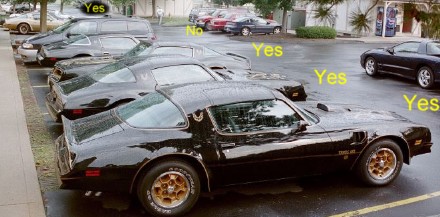
A single example is sufficient proof. Here's a black 78 4-speed with t-tops and gold Snowflakes. It's not a Special Edition. I have several more like this, but I don't have a 77. Some researchers have reported that snowflake availability was restricted in 1977. This could have made the gold snowflakes more exclusive in 1977.

Myth #2: If my car is a black or gold it has to be a Special Edition.
This is never, ever true. Paint code #50, Solar Gold, seems to be the main source of trouble. Of course, #19 black was available across all GM car lines, but code 50 was a special Firebird color.This myth has some documentation behind it. The 1976 Pontiac brochure didn't list black as a Trans Am color. This was preliminary, and it's just not true. There were thousands of black 1976 T/A's made that weren't Special Editions. Also, lots of gold regular Trans Ams were made in 1978, and thousands more in 1979-80.
Some 1978 paint chip sheets have Solar Gold mis-named "Special Edition Gold" as if the color was only for Special Editions. But it's not. If you think this entitles you to claim you have a Gold Edition, all I can say is PMD, not PPG, makes that call. Going by the product announcements in Brett Campbell's 77 and 78 Dealer Manuals (see 78ta.com), Pontiac had planned to reserve Solar Gold for Special Editions only. They changed their minds, delaying the Gold Edition and making Solar Gold generally available in a memo dated August 1, 1977.
I would agree paint code #50 and the big gold hood chicken were designed for the Gold Edition. That is evident from the fact that the color wasn't used on other Pontiacs. My point is they weren't limited to the Gold Edition. When you see a 1979 Gold Edition for sale on ebay, just remember not to believe it.
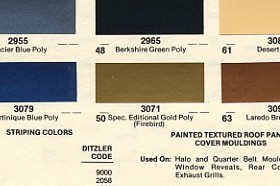
The car also had no t-tops. This is kind of off the subject, but there is no evidence of any Y88's without t-tops. If you think you have one, it could be worth a fortune, and you should get the documentation immediately. Also, here's a trivia item: All gold 1978 Trans Ams used the big 5-color hood bird that was designed for the Gold Special Edition.
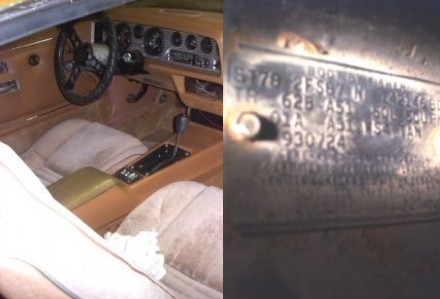
There are several instructive differences you can see clearly here:
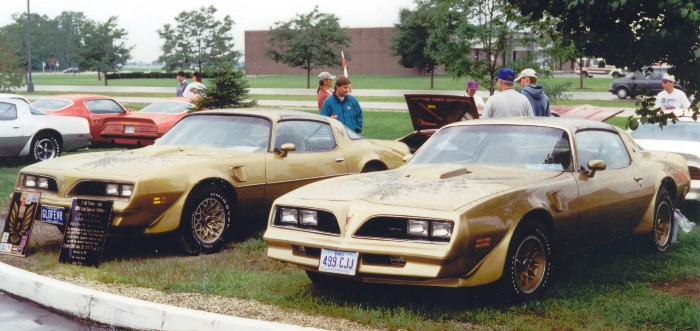
Here's a build sheet for a similar 1978 Solar Gold 4-speed Trans Am with gold snowflake wheels, built February 22, 1978. It's not a Special Edition. This non-Gold Edition was made toward the beginning of Gold Edition production, as far as I can tell from build sheets.
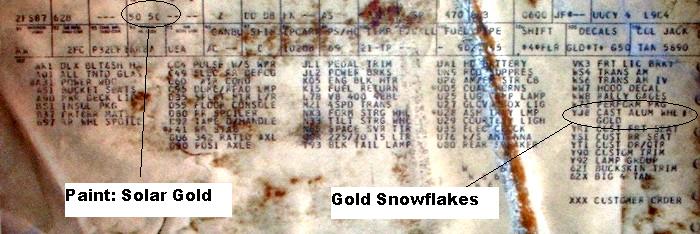
Myth #3: Special Editions have special performance features
A lot of times people will look at a performance option and then make the jump to "it's a bandit because it has chrome valve covers and a 160 mph speedometer". Not so. Even worse, some poeple fall for aftermarket equipment. If the car has a console-mounted Hurst dualgate shifter, hood pins, and a Holley carburetor, they'll imagine it's a rare "Hurst His-n-Hers Holley Hood Edition". And it's all factory. Sure.The black and gold "edition" cars were appearance packages only. There is no connection to anything speed, handling, or performance related. Even Burt Reynolds, driving like a maniac in "Smokey and the Bandit", displays the lo-po "6.6 liter" shaker decal in all scenes where the shaker is visible. Yeah, I know they didn't jump the creek with just 180 hp. But my point is that was a real decal made by GM for a real special edition with the standard engine. At right, check out Bruce Hamilton's Bandit photo from "back in the day". Red Interior, W72 engine, regular Pontiac shifter, and no WS6.
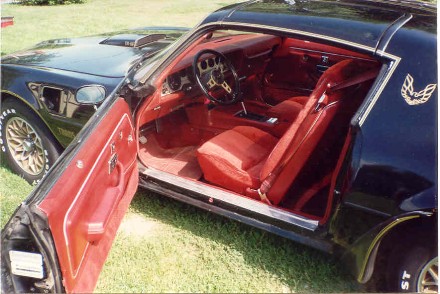
Myth #4: Special Editions are all loaded with options.
This one is like number 3, but it's so pervasive I am considering it separately. I'm not sure who ordered the 1976 Limited Editions or what they're like as a group. I can tell you, though, that from 1977 to 1981 there were no options required when a customer ordered a Special Edition. Order sheets, published option lists, and the population of cars clearly show this. Aluminum Wheels and T-tops were usually part of the package, but that's all. I used to think they all had deluxe interior, but I was wrong.My own car (PHS invoice sheet at top right) had nine options if you count floor mats, tinted glass, tan seat belts, and door edge guards. Terry Best's excellent 1976 (also at right) doesn't have tan seat belts. Dutch, beside #5 below, doesn't have air conditioning (and gets a special gold "dash chicken"). None of the 3 cars mentioned in this paragraph have power windows. I own a 1977 bandit with build sheet that didn't even have a radio.
This myth was caused by the many loaded Special Editions that were built. The appearance package alone was $1000, so it was a rich man's toy all the way. That's why so many were built "maxed out". In contrast to the Special Editions, Pontiac did make the 1979 10th Anniversary Trans Ams all alike, loaded, and this continued with the two white pace cars. But I digress.
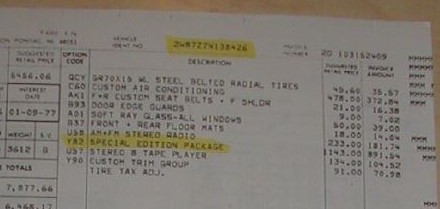
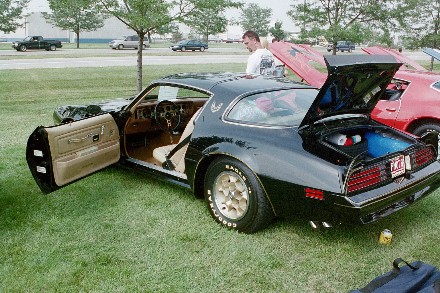
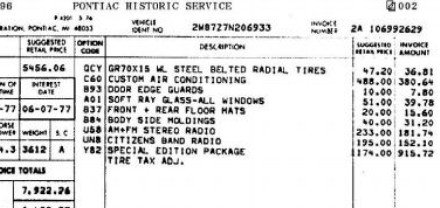
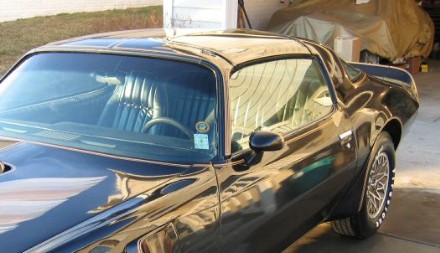
Myth #5: Special Editions had black interior.
Everybody knows this because they've seen Smokey and the Bandit (just kidding). According to the order sheets, any interior is possible in a black car. As your wife will tell you, everything goes with black.After many years, the Bandit club registry documented 1977 cars with every interior color. The order of popularity was Black, Saddle, White, Red, and Blue. It was a looooong time before we got that blue one. Dutch here is a fully documented red velour example, which happens to have no air conditioning (see #4 above). Combinations (like white seats with red dash) are probably not out there, but they could be because they were allowed with black.
This is the stuff of car show nightmare. Where you show up with something rare, beautiful, and restored correctly at great expense, but the moron in the tech line won't let you into the correct class because of a car chase movie.
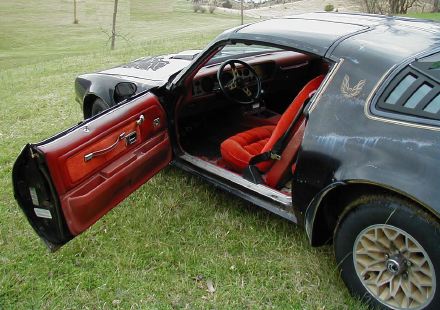
Myth #6: Gold Trim Items are a good way to prove that I have a Special Edition
There are actually 4 problems here.- People really like the gold trim, it's cheap, and lots of non-bandit cars have "gained" it. Even spray paint has been used, and it pains me to say I have been a victim of it.
- Time changes some of the colors in question. The red front arrowheads fade away to colorless, and the gold on the dash all flakes off. Black steering wheel spokes have turned to dirty bare aluminum. Does that look like gold? Hmm...?
- There is plenty of evidence that mistakes were made on the assembly line. I mean, if you were working, and a gold Trans Am with gold snowflakes came down the line, wouldn't you put gold wheel emblems on it? I sure would. Does that make each car with a wrong trim item one of kind? Yes, but maybe it's just cool without being "rare". Don't stoop to the level of Hot Wheels collectors.
- The gold nose arrowhead and wheel emblems were not developed until the Y88 came along. The 1976 had a special gold nose emblem, but the 1977 did not. Go back up to the picture of "Gold Fever" for both arrowheads.
Brian's first Gold Edition, also at right, was a nearly-new original car but had black grilles in this 20-year-old picture. Maybe somebody on the assembly line goofed?
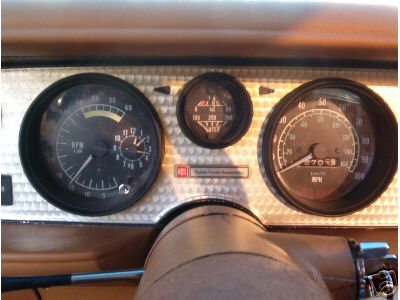

Myth #7: My buddy Sluggo looked at my VIN#, and he told me it was a Special Edition
Not without help from the factory he didn't. You'll need $35 for PHS, although GM Canada apparently does it free for cars they sold. There is a somewhat pervasive myth on the internet that some years, Special Editions were VIN coded X (instead of W). This apparently comes from John Gunnell's book "Firebird buyer's guide", where he screwed up and used Y85 (the RPO) instead of X87 (the model number) in the Pace Car VIN numbers. It's just dead wrong.Although you can't tell from the VIN, you can sometimes tell from the trim tag. If the car was originally blue, for example, that pretty much rules it out. A black car will have paint codes 19L 19U (see right). If it's a 1978-81 car built in Norwood, often the cowl tag will be stamped "Y84" or "Y88" (also see right) which is fine documentation if the plate hasn't been faked by some crook. Norwood stamped the base Firebird model number on the top of the plate, and they would go back and "correct" it by adding another model RPO code at the bottom. Lucky for us, they were pretty specific. These were stamped by human beings at the factory, so don't bet on it 100%.
This doesn't apply to Y81's, Y82's, or anything built in Van Nuys that I've seen. And I look. I've never seen a stamped Y82 ever. There is a myth floating around that Y82s should be stamped.
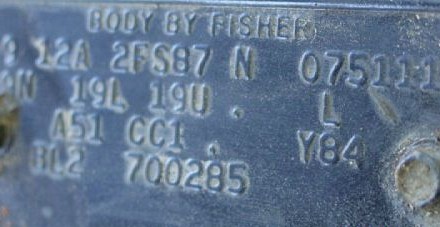
Myth #8: My car has rare gold-tinted Hurst t-tops
If I've heard this once, I've heard it 1000 times. The Gold Editions did have a unique t-top, but it wasn't made by Hurst, and it wasn't gold tinted. In fact, they don't have much tint at all. All Fisher t-tops have a faint one-way mirror on the inside to reflect sunlight, but the tinted glass looks dark from the outside. Unique Y88 Gold Edition t-tops had a heavy gold mirror inside and almost clear glass. In a gold car, they look the same color as the roof, and you can't easily see in. If you see these in a black car, you'll run right off the road and hit a tree. Here's an example at right. It's a real Y88 painted black. Once again, the steering wheel gives it away.There's no mistaking these t-tops once you know what they look like. You can see the reflection of this mirror from either side, but the outside is what matters. Remember that regular Fisher tops are mirrored too, and they look gold from inside, but that's nothing special. If you're trying to look through your t-tops to determine what color they're tinted, you can stop. It doesn't matter.
Equally important, none of the black Special Editions had anything gold on their t-tops except for a pinstripe. On this page (myths 1, 3, 4, and 5) there are five pictures showing the monochromatic look of the black Hurst t-tops, and these are unique Special Edition t-tops. "Regular" Hurst tops had silver frames. See the comparison at right.
Fisher t-tops, however, were normally all black and never had a special black-car version. They had black frames on all Firebirds and Camaros. Later, the black on the frames all flaked off, revealing a variety of colors underneath. This is a coatings failure, not a feature.
So, Why? Why do people think they have gold tinted Hurst tops? Really, they're brown tinted aren't they? I guess it looks gold kinda. A little. Maybe. On a cloudy day. The important thing is there's nothing rare about brown-tinted Hurst t-tops. If folks would say "I have rare black-framed Hurst t-tops" that would make sense.
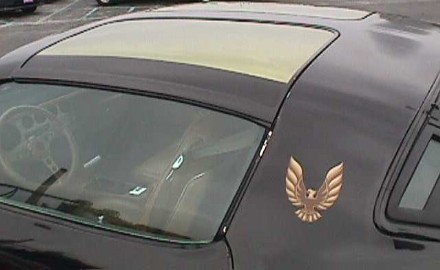
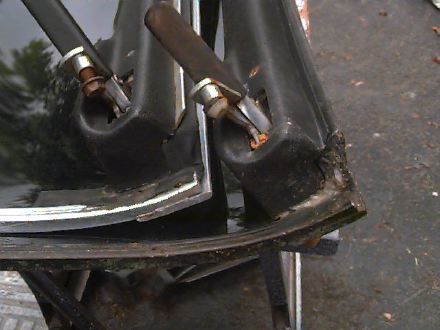
Myth #9: My car has special Y88 wheels
This is another widespread misconception. Pontiac decided to make an unusual snowflake in 1978, but only in gold, and only on the WS6 casting. This wheel may have been designed for the Gold Edition, but it is not unique to the Gold Edition. Rather, it's unique to 1978. Plus, many Gold Editions didn't have WS6 anyway and never wore this wheel (look at the "Gold Fever" picture above).The two machining styles are shown at right, and I hope you can see the difference. The 1978 wheel on the left is gold all over, while the 1981 wheel on the right has machined spokes and edge. I know from experience the 1978 Gray WS6 wheels were also fully machined.
There was an order book update in March 9th stating this, but notice it's called a "clarification" and not a change, so I don't think it started in March. Coindicentally, this was the exact day Brian's first Gold Edition was produced. Please notice that there's no mention of Y88 in this update, and the population of existing cars confirms that these wheels weren't unique to Y88's. They were just produced and used during a certain period of time, which includes the time that the non-Gold Edition parked beside "Gold Fever" was made.
It's possible that they changed the wheels during 1978 production, but I have no evidence of it. Pre-production photos and the 1978 Pontiac brochure show gold WS6 wheels fully machined, so somebody had to change his mind sometime. Check out the brochure below.
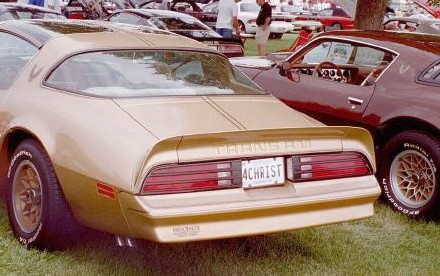
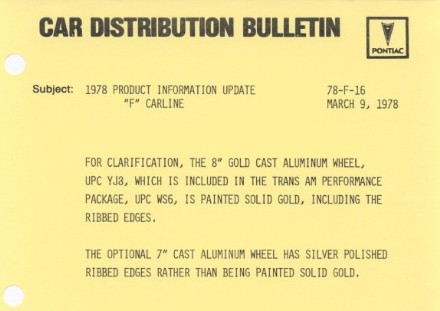
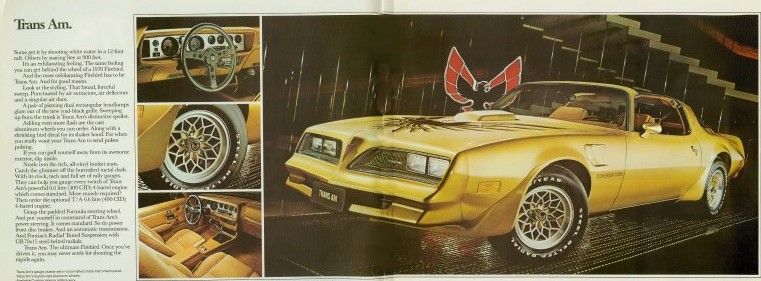
Things to notice:
- This clearly IS NOT a Y88 Gold Edition. There are about 10 things that give it away.
- The wheels are gold WS6 and fully machined. They wouldn't actually be made this way until 1979, as far as I know.
- This car appears to have black windshield molding, which actually is a Y88 feature.